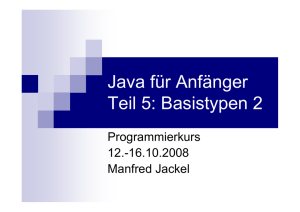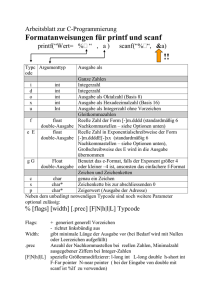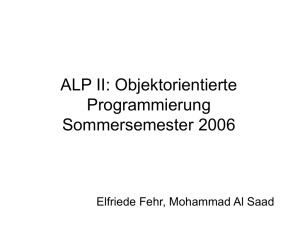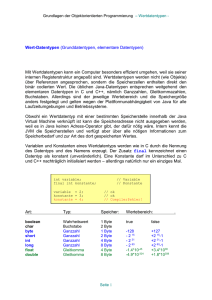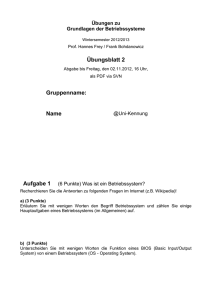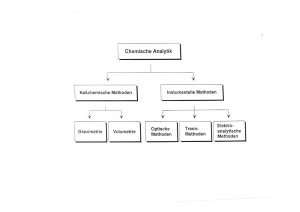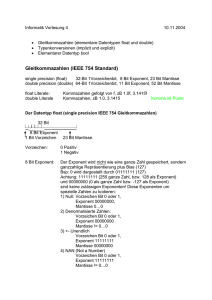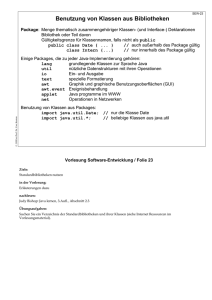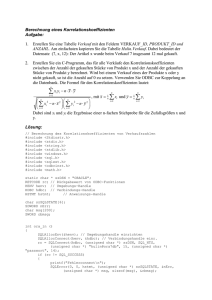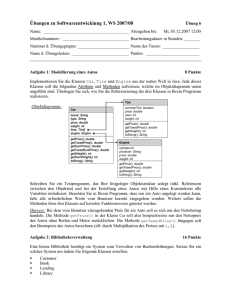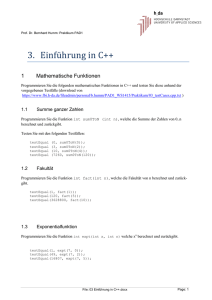Java für Anfänger
Werbung
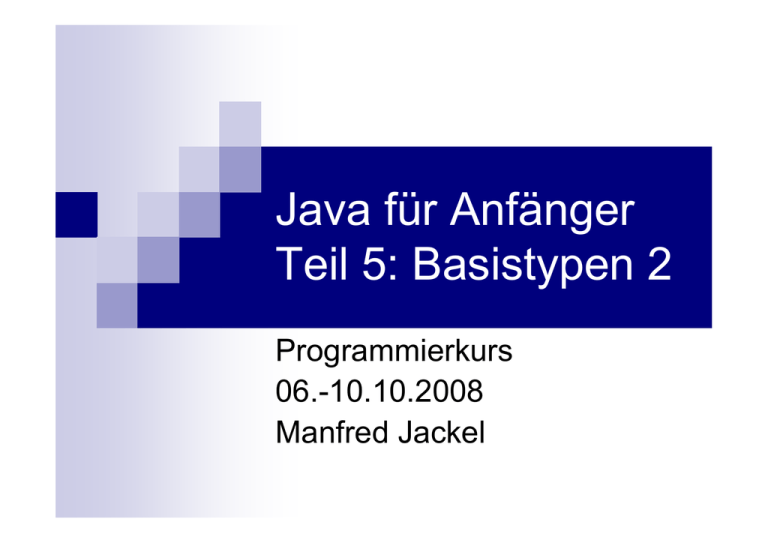
Java für Anfänger
Teil 5: Basistypen 2
Programmierkurs
06.-10.10.2008
Manfred Jackel
Char, String, Unicode
Der Zeichentyp char ist ein integraler Typ, nicht
vorzeichenbehaftet, kann alle Unicode-Zeichen
(Unicode 1) darstellen,´.
Literale des Typs char:
‘A‘,‘B‘,‘C‘
einfache Tüttelchen, “A“ ist ein String-
Literal!
\b, \t, \n, \f,\r, \‘, \“, \\, \ooo
Rückschritt, Tabulator, Zeilenschaltung,
Seitenvorschub, Rückschritt, einfaches Apostroph,
doppeltes Apostroph, 3-stellige Oktalzahl <= 0377
\uxxxx Unicode-Zahlwert, Hexadezimalwert \u0…\ufff
Datentyp char
Schlüsselwort char
char einBuchstabe;
einBuchstabe = ‘a‘;
einBuchstabe = \b; // Rückschritt
einBuchstabe = \ua; // Rückschritt
einBuchstabe = \u000a; // Rückschritt
\u0…\uff sind die Zeichen nach ISO 8859-1
‘a‘<‘b‘, Vergleichsoperation
Numerische Datentypen
Bereits bekannt: Ganzzahlige oder integrale
Typen byte, short, int, long
Fließkommazahlen nach IEE-754
float
(einfach Genauigkeit
Float.MIN_VALUE betragsmäßig kleinste Zahl !=0.0
Float.MAX_VALUE größte Zahl
double
(doppelte Genauigkeit)
Double.MIN_VALUE, Double.MAX_VALUE
Fließkomma-Literalte
FloatingPointLiteral::=
( Digits '.' [ Digits ] | '.' Digits ) [ Exponent ] [ FloatSuffix ] |
Digits ( Exponent [ FloatSuffix ] | [ Exponent ] FloatSuffix )
Digits::=
DIGIT { DIGIT }
Exponent::=
( 'e' | 'E' ) [ '+' | '-' ] Digits
FloatSuffix::=
'f' | 'F'| 'd' | 'D'
Fließkomma-Literalte
FloatingPointLiteral::=
( Digits '.' [ Digits ] | '.' Digits ) [ Exponent ] [ FloatSuffix ] |
Digits ( Exponent [ FloatSuffix ] | [ Exponent ] FloatSuffix )
0.
.0
1.2f
2.3d
3.4e56
6.7E-8d
1E-1
1d
1f
Zuweisungen numerischer Typen
Java ist streng typisierend bei den Basistypen
Zwei Typen sind gleich, wenn sie den gleichen
Namen haben.
Eine Variable kann nur Werte ihres eigenen Typs
annehmen.
Prüfung zur Compilezeit
Es gibt implizite (automatische) und explizite
Typumwandlungen
bei
numerischen Datentypen wird dann automatisch
konvertiert, wenn keine Bereichs- oder
Genauigkeitsprobleme auftreten können
Zuweisungen numerischer Typen
byte b;
short s;
int i;
long l;
float f;
double d;
d = f = l = i =s =b;
in dieser Kette treten keine
Bereichs- oder
Genauigkeitsprobleme auf
explizite Typumwandlung
zwischen integralen Typen:
i = (int)l;
b = (byte)s ;
Typecast, Typkonvertierung
durch Operator
„(typename)“
Widening conversions
The following 19 specific conversions on
primitive types are called the widening primitive
conversions:
byte to short, int, long, float, or double
short to int, long, float, or double
char to int, long, float, or double
int to long, float, or double
long to float or double
float to double
Narrowing conversions
The following 23 specific conversions on primitive types
are called the narrowing primitive conversions:
byte to char
short to byte or char
char to byte or short
int to byte, short, or char
long to byte, short, char, or int
float to byte, short, char, int, or long
double to byte, short, char, int, long, or float
class Test {
public static void main(String[] args) {
int big = 1234567890;
float approx = big;
System.out.println(big - (int)approx); }
}
Ausgabe
-46
Hüllklassen (Wrapper)
Zu jedem Basistyp gibt es eine Hüllklasse mit nützlichen
Werten und Funktionen
Name: Name des Basistyps in Großschreibung, fast(!)
Byte, Short, Integer, Long, Float, Double
Integer.MAX_VALUE, INTEGER.MIN_VALUE
Integer.ToString(014) == “12“;
Integer.parseInt(“ -1“) == -1
http://java.sun.com/j2se/1.4.2/docs/api/index.htm
l
java.lang.Integer
Methoden
